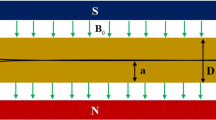Abstract
An analysis has been carried out to study the effect of magnetic field on an electrically conducting fluid of second grade in a parallel channel. The coolant fluid is injected into the porous channel through one side of the channel wall into the other heated impermeable wall. The combined effect of inertia, viscous, viscoelastic and magnetic forces are studied. The basic equations governing the flow and heat transfer are reduced to a set of ordinary differential equations by using appropriate transformations for velocity and temperature. Numerical solutions of these equations are obtained with the help of Runge-Kutta fourth order method in association with quasi-linear shooting technique. Numerical results for velocity field, temperature field, skin friction and Nusselt number are presented in terms of elastic parameter, Hartmann number, Prandtl number and Reynolds number. Special case of our results is in good agreement with earlier published work.
Similar content being viewed by others
Abbreviations
- v :
-
Dimensional velocity vector
- T :
-
Dimensional temperature
- p :
-
Pressure
- c :
-
Specific heat of the fluid at constant pressure
- x,y :
-
Dimensional space variables
- k :
-
Thermal conductivity
- h :
-
Heat transfer coefficient
- M:
-
Hartmann number
- Pr :
-
Prandtl number
- F :
-
Lorentz force
- B :
-
Magnetic field
- E :
-
Electric field
- J :
-
Current density
- I :
-
Identity tensor
- A 1,A 2 :
-
First two Rivlin Erickson tensors
- t :
-
Dimensional time variable
- K :
-
Non-dimensional viscoelastic parameter
- Nu :
-
Nusselt number
- Re :
-
Reynolds number
- ρ :
-
Density
- σ 0 :
-
Electric conductivity
- η :
-
Non-dimensional space variable
- σ :
-
Stress tensor
- μ :
-
Dynamic viscosity
- ν:
-
Kinematic viscosity
- θ :
-
Non-dimensional temperature
- α i (i=1,2):
-
Material constants
- ∇:
-
Nabla operator
- ∇2 :
-
Laplacian operator
- d/dt :
-
Material time derivative
References
Beard DW, Walters K (1964) Elasto-viscous boundary layer flow. Proc Camb Philos Soc 60:667–674
Böhme G (1981) Non-Newtonian fluid mechanics. North Holland, Amsterdam
Huigol RR, Phan-Thein N (1997) Fluid mechanics of viscoelasticity. Elsevier, Amsterdam
Akcay M, Yukselen A (1999) Drag reduction of a non-Newtonian fluid by fluid injection on a moving wall. Arch Appl Mech 69:215–225
Rivlin RS, Ericksen JL (1955) Stress deformation relations for isotropic materials. J Ration Mech Anal 4:323–425
Rivlin RS (1955) Further remarks on the stress deformation relations for isotropic materials. J Ration Mech Anal 4:681–702
Ayub M, Anis MR, Hayat T (2007) Slip effects on the flow of a third order fluid with variable suction. Meccanica 42:527–535
Dunn JE, Rajagopal KR (1995) Fluids of differential type critical review and thermodynamics analysis. Int J Eng Sci 33:689–747
Chung Liu I (2005) Flow and heat transfer of an electrically conducting fluid of second grade in a porous medium over a stretching sheet subject to a transverse magnetic field. Int J Non-Linear Mech 40(4):465–474
Berman AS (1953) Laminar flow in channels with porous walls. J Appl Phys 24:1232–1235
White FM (1958) Laminar pipe flow in a uniformly porous channel. J Appl Mech ASME 80:613–617
Teril RM (1965) Laminar flow in a uniformly porous channel with large injection. Aeronaut Q 16:323–332
Debruge LL, Han LS (1972) Heat transfer in a channel with a porous wall for turbine cooling application. J. Heat Transfer, Trans ASME 94:385–390
Hady FM, Gorla RSR (1998) Heat transfer from a continuous surface in a parallel free stream of viscoelastic fluid. Acta Mech 128:201–208
Sundaravadivelu K, Tso CP (2003) Influence of viscosity variations on the forced convection flow through two types of heterogeneous porous media with isoflux boundary condition. Int J Heat Mass Transfer 46(13):2329–2339
Asghar S, Nadeem S, Hossain M (2008) The Rayleigh Stokes Problem for rectangular pipes in Maxwell and second grade fluids. Meccanica 43:495–504
Goldstein RJ et al. (2001) Heat transfer—a review of 1999 literature. Int J Heat Mass Transfer 44(19):3579–3699
Goldstein RJ et al. (2002) Heat transfer—a review of 2000 literature. Int J Heat Mass Transfer 45:2853–2957
Goldstein RJ et al. (2003) Heat transfer—a review of 2001 literature. Int J Heat Mass Transfer 46:1887–1992
Ariel PD (2002) On exact solutions of flow problems of a second grade fluid through two parallel porous wall. Int J Eng Sci 40:913–941
Kurtcebe C, Erim MZ (2005) Heat transfer of a viscoelastic fluid in a porous channel. Int J Heat Mass Transfer 48:5072–5077
Hartmann J, Lazarus F (1937) Experimental investigations on the flow of mercury in a homogeneous magnetic field. Mat Fys Medd K Dan Vidensk Selsk 15:7
Dunn JE, Fosdick RL (1974) Thermodynamics, stability, and boundedness of fluids of complexity 2 and fluids of second grade. Arch Ration Mech Anal 56:191–252
Fosdick RL, Rajagopal KR (1979) Anomalous features in the model of second order fluids. Arch Ration Mech Anal 70:145–152
Wang CY, Skalak F (1974) Fluid injection through one side of a long vertical channel. AIChE J 20:603–605
Baris S (2002) Steady Three-Dimensional Flow of a Walter’s B’ fluid in a vertical channel. Turk J Eng Environ Sci 26:385–394
Author information
Authors and Affiliations
Corresponding author
Rights and permissions
About this article
Cite this article
Parida, S.K., Panda, S. & Acharya, M. Magnetohydrodynamic (MHD) flow of a second grade fluid in a channel with porous wall. Meccanica 46, 1093–1102 (2011). https://doi.org/10.1007/s11012-010-9368-y
Received:
Accepted:
Published:
Issue Date:
DOI: https://doi.org/10.1007/s11012-010-9368-y




